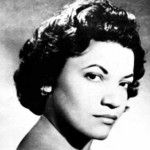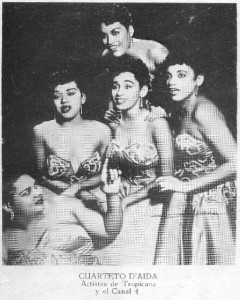![]() Born Romana Elena Burgues González on February 28, 1928 in Havana, Cuba – June 9, 2002 in Havana, Cuba, was a revered and popular Cuban singer of boleros and romantic ballads.
Born Romana Elena Burgues González on February 28, 1928 in Havana, Cuba – June 9, 2002 in Havana, Cuba, was a revered and popular Cuban singer of boleros and romantic ballads.
She possessed one of the most beautiful contralto voices of Cuban music. Dubbed as “La Señora Sentimiento” (lady feeling), she debuted in 1941 as an amateur singer in a CMQ radio program and barely a year after that, her voice and quality as an singer had paved the way of a professional career where she remained as a top figure until her death.
She started her career by working in radio in the 1940s but began to work with smaller groups in the 1950s. In 1952, pianist and arranger Aida Diestro organized the vocal quartet called Cuarteto d’Aida. The original members were , Moraima Secada, Omara Portuondo and Haydée Portuondo. After she got some attention, she went solo.
By the time of the Cuban revolution she was a top solo artist performing in elegant cabarets in Havana. Her voice seemed to become stronger with age, as her subtle yet sophisticated technique graced every song she sang with an emotional weight. Over the years she has performed with top Cuban dance bands such as Orquesta Aragón and with highly acclaimed singer-songwriters, including Pablo Milanés. She certainly could “take a sad song and make it better”, piercing the emotional veil of her audience with an almost palpable sincerity. Though she mostly interpreted classic Cuban boleros and Son, her versions were distinct, supported by top-notch musicians and arrangements. She was the mother of Malena Burke and grandmother of Lena, also well known Cuban singers.
Throughout his artistic life that if we have to date total six decades (starting professionally in 1942) Elena Burke represented the peculiar case of an interpreter for the quality of his technique and sound of his voice managed to make the song a timeless art, managing to fall away by future tense pluperfect, ie cancionística cultivated tradition, while experimenting with new forms lyrics of our time, making their work in a fruit very rich and complex human and musical stature. Elena dominated a vast repertoire that includes at least the last five decades of Cuban song from the top of the traditional trova decanted to the interpretation of contemporary song.
She has been one of the few if not the only one that managed to combine wisdom and good taste with styles as varied as those of Ernesto Lecuona, Silvio Rodriguez, Ignacio Piñeiro, Sindo Garay, Mirta Silva and Pablo Milanes. And that’s not an identification, but more emphatic proof of his status as a great stylist, which allowed him to embrace life as record keeping and how much there is on the staff, because she found her voice the wonder of the new.
Elena is gone, but here, standing, as he said in his song, has been feeling the Lady, whose legacy is the force of his voice portrayed in more than 20 LP and a huge sentimental map which guides the good reasons .
Agencies/Wiki/Elena’s/Internet Photos/YouTube/Arnoldo Varona/TheCubanHistory.com
THE CUBAN HISTORY, HOLLYWOOD.
![]() ELENA BURKE,”SRA. SENTIMIENTO”, CANTANTE. (Nacida en la Habana).
ELENA BURKE,”SRA. SENTIMIENTO”, CANTANTE. (Nacida en la Habana).
Born Romana Elena Burgues González el 28 de febrero de 1928 en La Habana, Cuba – 9 de junio de 2002 en La Habana, Cuba, fue una cantante cubana venerada y popular de boleros y baladas románticas.
Poseía una de las más bellas voces de contralto de la música cubana. Bautizado como “La Señora Sentimiento” (sensación dama), que debutó en 1941 como cantante amateur en un programa de radio CMQ y apenas un año después de eso, su voz y su calidad como cantante había allanado el camino de una carrera profesional donde permaneció como una figura superior hasta su muerte.
Comenzó su carrera trabajando en la radio en la década de 1940, pero comenzó a trabajar con grupos más pequeños en la década de 1950. En 1952, el pianista y arreglista Aida Diestro organizaron el cuarteto vocal llamado Cuarteto d’Aida. Los miembros originales eran, Moraima Secada, Omara Portuondo y Haydée Portuondo. Después se puso un poco de atención, se lanzó como solista.
En la época de la revolución cubana era una artista en solitario con mejor desempeño en cabarets elegantes en La Habana. Su voz parecía ser más fuerte con la edad, ya que su técnica sutil y sofisticado adornaba cada canción que cantó con un peso emocional. A través de los años ha actuado con las principales orquestas de baile cubanos como la Orquesta Aragón y con la aclamada canción de autor, como Pablo Milanés. Ciertamente podría “tomar una canción triste y hacerlo mejor”, el levantamiento del velo emocional de su audiencia con una sinceridad casi palpable. A pesar de que la mayoría interpreta boleros clásicos cubanos y su hijo, sus versiones eran distintas, con el apoyo de músicos y arreglos de primera categoría. Ella era la madre de Malena Burke y abuela de Lena, también conocido cantantes cubanos.
A lo largo de su vida artística que si tenemos hasta la fecha un total de seis décadas (a partir profesionalmente en 1942) Elena Burke representado el caso particular de un intérprete para la calidad de su técnica y el sonido de su voz logró hacer la canción un arte intemporal, logrando caer por el futuro pluscuamperfecto tensa, es decir cancionística tradición cultivada, mientras que la experimentación con nuevas formas de letras de nuestro tiempo, haciendo su trabajo de una fruta de la estatura humana y musical muy rica y compleja. Elena dominó un vasto repertorio que incluye al menos las últimas cinco décadas de la canción cubana de la parte superior de la trova tradicional decantada a la interpretación de la canción contemporánea.
Ha sido uno de los pocos, si no el único que logró combinar la sabiduría y el buen gusto con estilos tan variados como los de Ernesto Lecuona, Silvio Rodríguez, Ignacio Piñeiro, Sindo Garay, Mirta Silva y Pablo Milanés. Y eso no es una identificación, pero la prueba más contundente de su estatus como un gran estilista, lo que le permitió abrazar la vida como el mantenimiento de registros y de lo mucho que hay en el personal, porque ella encontró su voz la maravilla de lo nuevo.
Elena se ha ido, pero aquí, de pie, como dijo en su canción, se ha sentido la Dama, cuyo legado es la fuerza de su voz representada en más de 20 LP y un enorme mapa sentimental que guía las buenas razones.
Agencies/Wiki/Elena’s/Internet Photos/YouTube/Arnoldo Varona/TheCubanHistory.com
THE CUBAN HISTORY, HOLLYWOOD.







